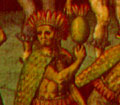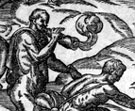> DRY
DRUNK
TRAVEL AND DISCOVERY
In 1492, when the floodgates of European explorers opened on North and South
America, the many different native cultures there already had long traditions
of chewing, smoking, and snuffing tobacco, sometimes in conjunction with
other psychotropic plants. Used regularly in ritual and social contexts,
tobacco and its counterparts were appreciated precisely for their physiological
and mind-altering effects, which, among other things, aided the Amerindians
in their pursuit of the supernatural. The early explorers who "discovered" the
Americas soon grasped the importance of the plant within native cultures,
and verbal and then pictorial descriptions of its use were featured in virtually
all publications about the New World. According to these descriptions, native
uses ranged from shamanistic ritual, in which the shaman and sometimes other
individuals inhaled tobacco smoke to the point of collapse, to recreational
consumption. André Thevet, a French monk turned royal cosmographer
who traveled briefly to Brazil in 1555, reported that the natives "esteeme
it maruellous profitable for many things. . . . They say it is very holesome
to cleanse & consume the superfluous humors of the brain. Moreover being
taken after this sort, it kepeth the parties from hu[n]ger & thirst for
a time. . . ." The novelty of smoking itself, as well as specific rituals
such as smoking a pipe of tobacco in peaceful greeting or in preparation
for war, provided ample material for study and speculation.
1
Theodor de Bry (Flemish, active in Germany, 1528–1598)
Shamanic tobacco dance among the Tupinambà Indians of Brazil
Two hand-colored engravings from: Jean de Léry (French, 1534–1611). Americae
Tertia Pars. Memorabile provinciae Brasiliae Historiam [The third part of America,
containing the remarkable history of the province of Brazil]. Frankfurt:
Johann Wechel and Theodor de Bry, 1592 Rare Books Division
 Beginning in 1591, de Bry sought out the rights for many of the most
significant New World publications of the previous decades, and reissued
them in a series collectively known as the Grands Voyages, with new, elaborately
engraved illustrations, here seen extracted from the volumes and colored
by hand. The lower image on display shows a magical use of tobacco. According
to According to Léry, a Calvinist chaplain attached to Villegagnon's
expedition to Brazil, as the natives inhaled the tobacco smoke that was
blown at them, the caraïbe or shaman would chant: "So that you may
overcome your enemies, receive all of you the spirit of strength."
Beginning in 1591, de Bry sought out the rights for many of the most
significant New World publications of the previous decades, and reissued
them in a series collectively known as the Grands Voyages, with new, elaborately
engraved illustrations, here seen extracted from the volumes and colored
by hand. The lower image on display shows a magical use of tobacco. According
to According to Léry, a Calvinist chaplain attached to Villegagnon's
expedition to Brazil, as the natives inhaled the tobacco smoke that was
blown at them, the caraïbe or shaman would chant: "So that you may
overcome your enemies, receive all of you the spirit of strength."
2
A. Walker (British, 1st half 18th century)
The Mohawk Indian Warrior, with His Tomax, Scalping-Knife, &c.
Etching, n.d.
Print Collection, Duyckinck Collection
Despite major efforts to "civilize" the native Americans, European fascination
with their wilder side remained strong well into the 18th century and beyond.
Here, an unnamed warrior is shown with his tomax, an instrument of peace
and war all wrapped into one.
3
Aldert Meyer (Dutch, born 1663/4, active in Amsterdam 1686–88)
Engelse Quakers en Tabakplanters aende Barbados [English Quakers and
tobacco growers on Barbados]
Etching from: Carel Allard (Dutch, 1648–ca. 1706). Orbis Habitabilis
oppida et vestitus [Cities and costumes of the inhabited world] Amsterdam:
Carel Allard, ca. 1690–1700
Print Collection, I. N. Phelps Stokes Collection
4
Unidentified (Dutch, mid-17th century)
Nieu Amsterdam
Etching, n.d.
Print Collection, I. N. Phelps Stokes Collection
 Tobacco –seen in leaf form, held by the man, and rolled onto
spindles for export –was a boon to colonial business throughout the
colonies, as these depictions of growers and merchants on the islands of
Barbados and Manhattan showcase. In typical 17th-century fashion, the very
same figures that represent Barbados Quaker planters in one etching represent
New Amsterdam tobacco merchants in the other. This was presumably a measure
of economy on the part of the publisher: only the distant background had
to be drawn from scratch to indicate the new place.
Tobacco –seen in leaf form, held by the man, and rolled onto
spindles for export –was a boon to colonial business throughout the
colonies, as these depictions of growers and merchants on the islands of
Barbados and Manhattan showcase. In typical 17th-century fashion, the very
same figures that represent Barbados Quaker planters in one etching represent
New Amsterdam tobacco merchants in the other. This was presumably a measure
of economy on the part of the publisher: only the distant background had
to be drawn from scratch to indicate the new place.
Quakers, or Friends, settled colonial America and the West Indies within
the first decade following George Fox's formation of the sect in England
in 1649. Although their beliefs discouraged the amassing of money for itself,
Quakers were found at virtually all levels of society; some were quintessential
farmers, while others were known as shrewd but honest merchants.
5
Unidentified (Dutch, 1st quarter 18th century)
Dance du calimet chez les Illinois [Dance of the calumet among the
Illinois]
Etching in: Pieter van der Aa (Dutch, active 1682–1733). La Galerie
Agréable du Monde . . . le Tome Second d'Amérique [The pleasurable
gallery of the world . . . the second volume of America], vol. 64. Leiden:
Pieter van der Aa, 1729
Print Collection
At the core of van der Aa's 65-volume "pleasurable gallery" are de Bry's
plates from a century before, but there are numerous new etchings as well,
including the scenes on exhibit, which update the style and add new information.
The term "calumet" is derived from a Norman French word for "reed," and
was used by the French to identify the Amerindian "peace pipe." Generally
about 1 1/2 feet long with a bowl made of Dakota soapstone, it was an object
of tremendous ceremonial significance, smoked in declarations of war and
peace and in friendly greeting. This plate shows a variety of episodes
in which the long-stemmed pipe was used: from the welcoming scene in the
tent at left, to the ceremonial dance performed at center right.
6
Unidentified (French, mid-16th century)
Portrait of Petun, or Tobacco
Woodcut in: André Thevet (French, 1502–1590). La Cosmographie
Universelle d'André Thevet Cosmographe du Roy. Illustrée de Diverses
Figures des choses plus remarquables veues par l'Autheur, & incogneues
de noz Anciens & Modernes [Universal cosmography of André Thevet,
cosmographer of the King. Illustrated with various images of the most remarkable
things seen by the author, & unknown by the ancients or the moderns]. Paris:
Guillaume Chaudière, 1575
Rare Books Division
 Thevet preceded Léry on the short-lived French expedition to
Brazil, but he fell ill almost immediately upon arrival and thus did not
see much of the New World. Nonetheless, he published an account of "antarctic
France" soon after his return home.
Thevet preceded Léry on the short-lived French expedition to
Brazil, but he fell ill almost immediately upon arrival and thus did not
see much of the New World. Nonetheless, he published an account of "antarctic
France" soon after his return home.
The inaccuracy of detail in this "portrait" –the first representation
to show natives smoking cigars of the "secrete herbe" –led his rival
Léry to contend that Thevet was not responsible for introducing
seeds of Nicotiana tabacum (the most commonly smoked genus of tobacco)
into France as he claimed to have done. Regardless of accuracy, images
such as this one provided a means of visualizing the distant, exotic lands
for contemporary European readers, especially when the images were paired
with the texts of seasoned travel writers such as Thevet.
7
William Hole (British, active 1607–46)
Map of Virginia. Discovered and Discribed by Captayn John Smith
Engraving in: John Smith (British, 1580–1631). The Generall Historie
of Virginia, New-England, and the Summer Isles. . . . London: I. D. and
I. H. for Michael Sparkes, 1627
Arents Tobacco Collection
Smith's History of Virginia, published in numerous editions starting
in 1624, represents a different phase of New World activity. Earlier attempts
at establishing colonies in Virginia had failed. Only the sixth expedition,
in 1606, gained some measure of success, and this has been credited to
the success of tobacco farming, as the newfangled habit of tobacco "drinking" steadily
gained popularity back in England.
In the upper-left-hand corner of this map of Virginia, the first accurate
mapping of the Chesapeake Bay area, Captain Smith's reception by the chief
Powhatan in 1607 can be seen, on the occasion that prompted Pocahantas
to save his life.
8
Moses van Uyttenbroeck (Dutch, ca. 1595/1600–1645/46)
Harvesting and curing of tobacco
Etching in: Johann Neander (German, ca. 1596–ca. 1630). Tabacologia. Leyden:
Isaac Elzevier, 1622
Arents Tobacco Collection
A self-described philosopher and physician, Neander derived most of
the information in his "medical - surgical - pharmaceutical" treatise on
tobacco from 16th-century herbals. Scenes of native American cultivation
and curing of tobacco such as this one, however, were almost completely
new. The plates both served as ethnographic information and provided practical
instruction, in keeping with his argument that tobacco should be grown
domestically since, for medicinal purposes, the green leaves were considered
preferable to the dried product.
Warning against recreational abuse of tobacco, however, Neander noted
that a man was said to have lost the sense of smell from taking too much
smoke. Somewhat cynically, he noted that those selling the herb had profited
greatly from the fashionable love of its "pleasant perfume," which he termed
a "stinking and filthy smell."


